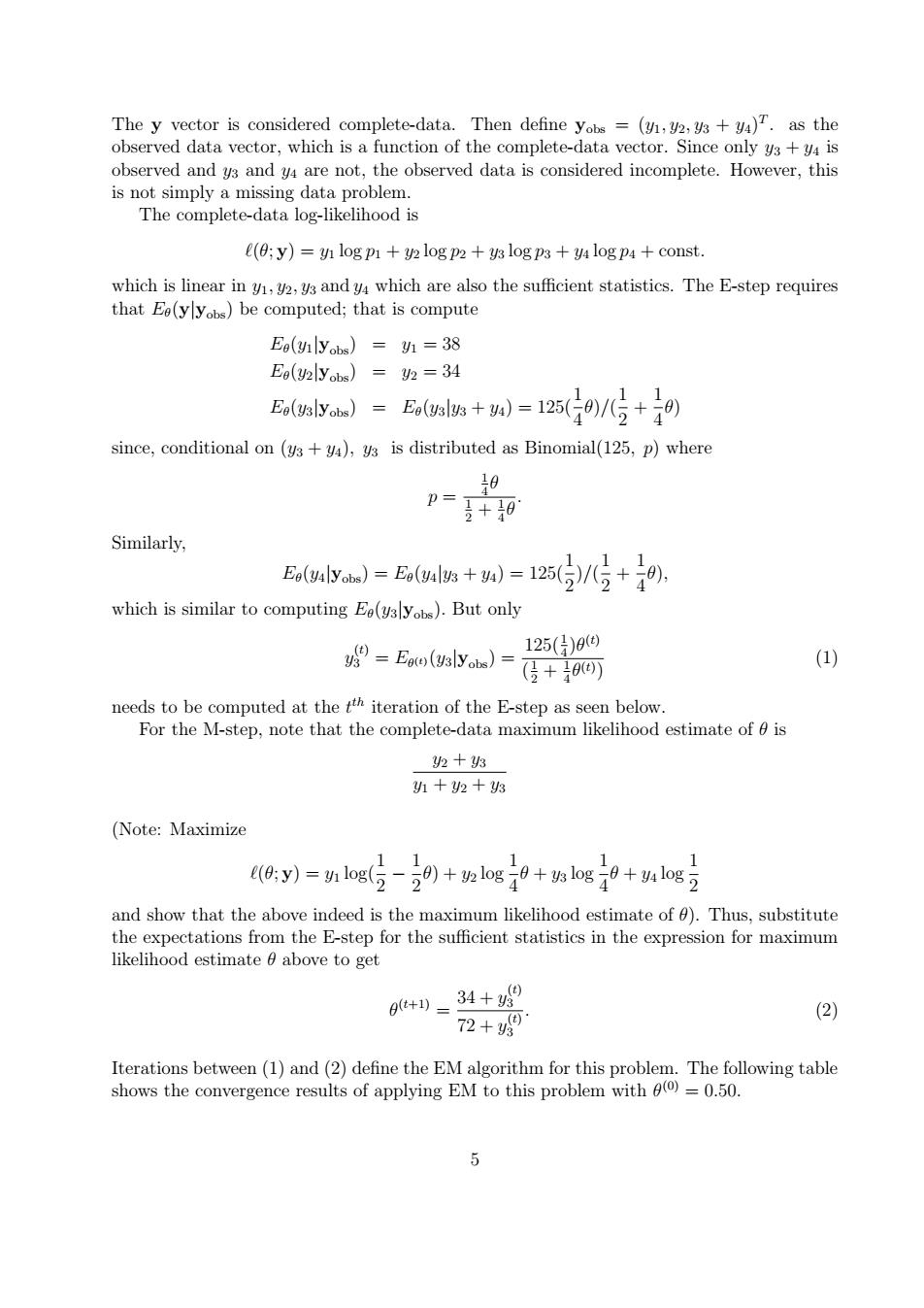正在加载图片...

The y vector is considered complete-data.Then define yobs =(v1,42,y3+)T.as the observed data vector,which is a function of the complete-data vector.Since only y3+y4 is observed and y3 and y4 are not,the observed data is considered incomplete.However,this is not simply a missing data problem. The complete-data log-likelihood is e(0;y)=y1 log pi +y2 log p2 +y3 logp3+y4log p4+const. which is linear in y1,y2,y3 and y4 which are also the sufficient statistics.The E-step requires that Ee(yyobs)be computed;that is compute Eo(v1lyobs)=1=38 E(y2 yobs)=2=34 E.(mlyu)E(alu)125() since,conditional on (y3+44),y3 is distributed as Binomial(125,p)where 0 p=+9 Similarly, Eobo)=Ea6a的+an)=12sG/rg+, which is similar to computing Ee(ysyobs).But only =Eoc)(u3lyobs)= 125(4)99 (3+9 (1) needs to be computed at the tth iteration of the E-step as seen below. For the M-step,note that the complete-data maximum likelihood estimate of is 2+的 班+2+3 (Note:Maximize 11 1 1 1 69:y)=hlog(吃-2)+%log49+h1og40+4log2 and show that the above indeed is the maximum likelihood estimate of )Thus,substitute the expectations from the E-step for the sufficient statistics in the expression for maximum likelihood estimate 0 above to get 9+1)=34+259 72+ (2) Iterations between (1)and(2)define the EM algorithm for this problem.The following table shows the convergence results of applying EM to this problem with 0(0)=0.50. 5The y vector is considered complete-data. Then define yobs = (y1, y2, y3 + y4) T . as the observed data vector, which is a function of the complete-data vector. Since only y3 + y4 is observed and y3 and y4 are not, the observed data is considered incomplete. However, this is not simply a missing data problem. The complete-data log-likelihood is `(θ; y) = y1 log p1 + y2 log p2 + y3 log p3 + y4 log p4 + const. which is linear in y1, y2, y3 and y4 which are also the sufficient statistics. The E-step requires that Eθ(y|yobs) be computed; that is compute Eθ(y1|yobs) = y1 = 38 Eθ(y2|yobs) = y2 = 34 Eθ(y3|yobs) = Eθ(y3|y3 + y4) = 125(1 4 θ)/( 1 2 + 1 4 θ) since, conditional on (y3 + y4), y3 is distributed as Binomial(125, p) where p = 1 4 θ 1 2 + 1 4 θ . Similarly, Eθ(y4|yobs) = Eθ(y4|y3 + y4) = 125(1 2 )/( 1 2 + 1 4 θ), which is similar to computing Eθ(y3|yobs). But only y (t) 3 = Eθ (t) (y3|yobs) = 125( 1 4 )θ (t) ( 1 2 + 1 4 θ (t) ) (1) needs to be computed at the t th iteration of the E-step as seen below. For the M-step, note that the complete-data maximum likelihood estimate of θ is y2 + y3 y1 + y2 + y3 (Note: Maximize `(θ; y) = y1 log( 1 2 − 1 2 θ) + y2 log 1 4 θ + y3 log 1 4 θ + y4 log 1 2 and show that the above indeed is the maximum likelihood estimate of θ). Thus, substitute the expectations from the E-step for the sufficient statistics in the expression for maximum likelihood estimate θ above to get θ (t+1) = 34 + y (t) 3 72 + y (t) 3 . (2) Iterations between (1) and (2) define the EM algorithm for this problem. The following table shows the convergence results of applying EM to this problem with θ (0) = 0.50. 5